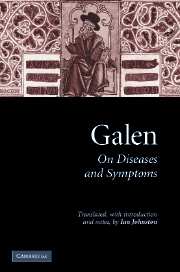Book contents
- Frontmatter
- Contents
- List of tables
- Acknowledgements
- List of abbreviations
- PART I INTRODUCTION
- PART II TRANSLATION
- II.0 Introduction
- II.1 On the Differentiae of Diseases
- II.2 On the Causes of Diseases
- II.3 On the Differentiae of Symptoms
- II.4 On the Causes of Symptoms I
- II.5 On the Causes of Symptoms II
- II.6 On the Causes of Symptoms III
- PART III CONCLUSION
- Bibliography
- Index
II.3 - On the Differentiae of Symptoms
Published online by Cambridge University Press: 22 September 2009
- Frontmatter
- Contents
- List of tables
- Acknowledgements
- List of abbreviations
- PART I INTRODUCTION
- PART II TRANSLATION
- II.0 Introduction
- II.1 On the Differentiae of Diseases
- II.2 On the Causes of Diseases
- II.3 On the Differentiae of Symptoms
- II.4 On the Causes of Symptoms I
- II.5 On the Causes of Symptoms II
- II.6 On the Causes of Symptoms III
- PART III CONCLUSION
- Bibliography
- Index
Summary
SYNOPSIS
I.1 A statement of the same aim for symptoms (i.e. complete classification) as for diseases in De morborum differentiis. Everything contrary to nature is either a disease, a cause of disease, or a symptom, this last including epiphenomena.
I.2 Consideration of the term ‘condition’ (diathesis), important for definitions.
I.3 Discussion of the term ‘affection’ (pathos or pathema) and its distinction from ‘disease’.
I.4 A digression on the general issue of terminology and its relative importance.
I.5 A summary of the distinctions between ‘health’ (hugieia), ‘disease’ (nosos) and ‘affection’ (pathos/pathema) and a restatement of their definitions.
I.6 A definition of ‘cause’ and an enumeration of types of ‘cause’ resembling the Aristotelian classification, and also distinguishing between ‘primary’ (per se) and ‘secondary’ (per accidens) causes.
I.7 A definition of ‘symptom’ (and epiphenomenon) and the distinction from ‘disease’ and ‘cause of disease’.
I.8 Consideration of the distinction between ‘symptom’ and ‘affection’ and their possible overlap.
II.1 A division of symptoms into: (i) conditions of the body itself; (ii) damage to functions; (iii) things that follow the former (excess of secretion or retention, abnormal noises). A division of loss of function into ‘privation’ and ‘disorder’.
II.2 Further consideration of the differentiation between ‘symptom’, ‘disease’ and ‘cause of disease’.
III.1 A statement of the basic divisions of the classification of symptoms: (i) all symptoms into ‘psychical’ and ‘physical’; (ii) ‘psychical’ symptoms into ‘sensory’, ‘motor’ and ‘authoritative’; (iii) ‘sensory’ symptoms into those of sight, hearing, smell, taste and touch; (iv) symptoms of each of the senses into loss of sensation and abnormal sensation with subdivision of the latter into ‘indistinctly’ and ‘falsely’.[…]
- Type
- Chapter
- Information
- Galen: On Diseases and Symptoms , pp. 180 - 202Publisher: Cambridge University PressPrint publication year: 2006



